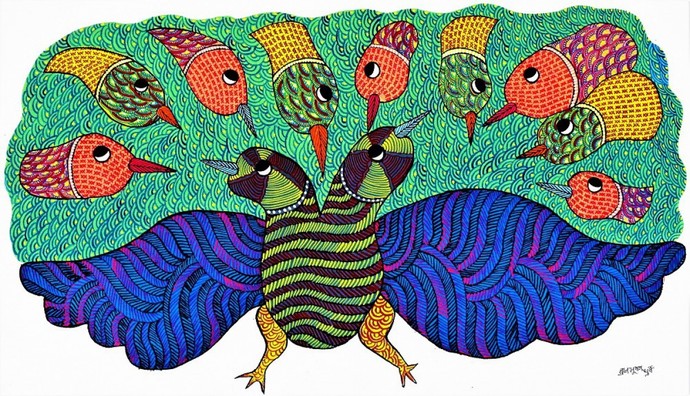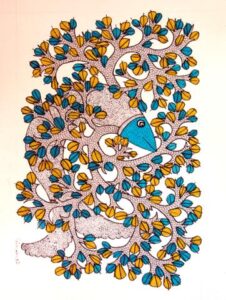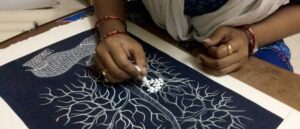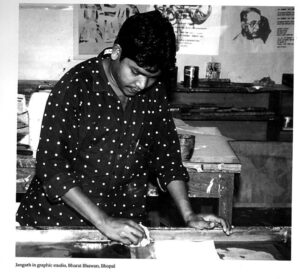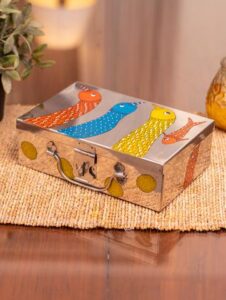Gond paintings: Of tribes, traditions and art
“Art in India does not wait for a canvas or paint. Rock surfaces and caves, a village wall, the floor, a palm leaf, a piece of wood, or even the palm of a hand is space enough and that is exactly what Gond represents – staying in harmony with nature,” says Gareeba Singh Tekam, an artist of the Gond tribe in Madhya Pradesh’s capital Bhopal.
Tekam teaches Gond paintings in a local centre and has been working to preserve the art form for over a decade now. The art that he practices, Gond art, is a form of a tribal painting belonging to the eponymous tribe, one of the largest in India.
The Gond number around 12 million according to figures from Census 2011. The Gond mainly live in the Deccan plateau in the region spanning across northern Andhra Pradesh, eastern Maharashtra, Madhya Pradesh, Jharkhand and western Odisha.
The word ‘Gond’ comes from the word Kond, meaning green mountains, the dwelling places of the Gond. Tekam says that the origin of Gond paintings can be traced back to the same era as the origin of the Gonds themselves, roughly about 2000 years ago.
“The Gond could just be imitating their ancestors as there are cave paintings in the region that go all the way back to the Mesolithic Period. Paintings, as well as other art forms, have always been quite popular with tribal people in India, especially the Gond tribe,” says Ajay Narayan, a professor of History at the University of Delhi who is also working with Gond artists to preserve their art and culture.
He goes on to say that Gond has a belief that viewing a good image begets good luck. This belief led the Gond to decorate the walls as well as the floor of their houses with traditional tattoos and motifs. “Gond paintings have also been used by the tribe as a way to record its history,” he adds.
One with the nature
The Gond have traditionally drawn inspiration, as well as, represented their stories using strong natural elements. Trees, animals, birds and other environmental representation are amongst the most recognisable elements in their visual art.
“From mythological tales and oral histories to traditional songs, natural surroundings, important events and rituals, the Gond recreate the past with intense mastery of technique and profound intricacy,” says Narayan.
Even amongst the Gond, it was most prominent among the Pardhan (priest) Gonds, who were renowned for their artistic skills, be it painting or music. Most Gonds follow Hindu customs but some are animists. They believe that natural objects like mountains, lakes and animals, everything is inhabited by a spirit or life force. These spirits should be respected and painting them is a way of showing reverence. The Gonds also have a tradition of painting walls and floors of their huts during important festivities.
While a majority of Gond paintings are inspired by nature, it is not the only source of inspiration. Gond paintings also take inspiration from myths and legends of India or alternatively, they may also showcase images from the daily lives of the tribe. “It can also showcase abstract concepts like emotions, dreams and imagination,” adds Narayan.
The artistic techniques
One of the most captivating features of this art is its simplicity, both, in terms of the tools required to make the painting, as well as, the painting itself. A canvas or a cloth, or even chart paper along with basic paint is all that is required to start making a Gond painting.
Yet in the simplicity lies incredible intricacy and care. Paintings are also commonly done on mud walls. “A special soil, freely available in local areas, called Pidor is used for preparing the surface of the wall for the painting,” says Tekam.
The artists draw the inner as well as outer lines with as much care as possible so that the perfection of the lines has an immediate effect on the viewer. Lines are used in such a way that it conveys a sense of movement to the still images. Dots and dashes are added to impart a sense of faster movement and increase the amount of detail.
Another very striking facet of Gond paintings is the use of bright vivid colours such as white, red, blue and yellow. “The paints are usually derived naturally from objects such as charcoal, coloured soil, plant sap, leaves, flowers, barks and even cow dung,” says Tekam.
More specifically, he explains, the yellow colour is derived from Chui mitti, which is a type of local soil, brown from Gheru mitti, another type of soil, green is readily procured from leaves while the colour red is obtained from the Hibiscus flowers.
Before mass-produced paints were available, the tribe’s artwork was rarely, if ever, committed to paper. But one day in 1981, everything changed.
From wall to canvas: Jangarh Singh Shyam
In 1980, a major new art centre, Bharat Bhavan, was built in Bhopal. The man in charge, Jagdish Swaminathan, wanted to exhibit both modern and indigenous art and so, he sent out scouts in search of talent. One of the finds of this talent search was a 17-year-old Gond, Jangarh Singh Shyam, who was invited to paint murals at the Bharat Bhavan. After seeing the murals Shyam had painted, Swaminathan persuaded him to move to Bhopal and experiment with paints and canvas. Shyam went on to become a legendary name in contemporary Gond painting,
He created hypnotic paintings bursting with colour and motion. His reputation spread rapidly. In 1989, his work was displayed at the ‘Magiciens de la Terre’ exhibition in Paris. Just over a decade later, he took up a prestigious residency in Japan, at the Mithila Museum in Niigata.
“Shyam has inspired a legacy of Gondi tribal art. Up until the 1980s, Gond tribal art was unknown to outsiders, used only to decorate their homes. Now, just over 40 years later, it is exhibited in galleries worldwide,” says Tekam.
Contemporary modifications
Modern Gond paintings are not painted on walls and floors and are instead painted on canvas. This makes sure that it is not only much easier to transport, carry and hang on a wall, but the use of canvas helps the paintings to stand out much more than they would if they were made on a wall. Due to the scarcity of natural colours in the current age, contemporary Gond artists like Tekam have started to use artificial colours.
“This combined with the use of canvas has made modern Gond paintings much more vivid than its traditional counterparts and if we don’t modify ourselves according to the changing times, it will be difficult to sustain in a world where everything is available,” says Tekam.
Gond paintings have also become quite common on wooden trays, boxes and other miscellaneous objects which have helped to increase its popularity and spread awareness. These paintings, artists say, are of such good quality that it lasts even beyond 20 years or so, without any external tampering.
“Apart from adorning the walls of art galleries, contemporary Gond painting is also found in private aircraft, trains, stations or homes of the rich get the tribal artists to give an aesthetic touch to their homes,” says Tekam, who has recently finished painting a television celebrity’s bar.
He goes on to say that while the contemporary Gond artists use modern materials and methods but they also brilliantly represent contemporary scenes and concerns while keeping true to age-old traditions and style. A Gond painting can sell for anywhere between a few thousand rupees to millions, depending on the intricacy of the work and material used by the artist.
“Gond Artists are no longer faceless, nameless unknown artists but have made a mark with their own unique individual artistic identities in the global art market,” he adds.

